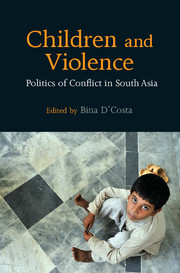Book contents
- Frontmatter
- Dedication
- Contents
- List of Map, Figures and Tables
- Acknowledgements
- Introduction: ‘Turtles Can Fly’: Vicarious Terror and the Child in South Asia
- Part I Shaping Childhood in South Asia
- Part II Conflict and Violent Peace
- Part III Rights, Needs and Protection
- Part IV Reflections from Human Rights Advocates in the Region
- Bibliography
- Notes on Contributors
- Index
Introduction: ‘Turtles Can Fly’: Vicarious Terror and the Child in South Asia
Published online by Cambridge University Press: 05 June 2016
- Frontmatter
- Dedication
- Contents
- List of Map, Figures and Tables
- Acknowledgements
- Introduction: ‘Turtles Can Fly’: Vicarious Terror and the Child in South Asia
- Part I Shaping Childhood in South Asia
- Part II Conflict and Violent Peace
- Part III Rights, Needs and Protection
- Part IV Reflections from Human Rights Advocates in the Region
- Bibliography
- Notes on Contributors
- Index
Summary
Nearly 30 people came to our house. I recognised many of them as my neighbours. They beat my mother almost senseless. I begged them to stop. They dragged me outside. I resisted but they hit me with sticks. I screamed at my sister to save me but they beat her too. I cannot tell you what happened next.
Post-election violence erupted in Bangladesh in late 2001, affecting minority communities living in the peripheries of the state.3 On 8 October, 11 alleged perpetrators gang-raped Purnima, a 12 year-old girl. A judicial probe commission in its report nearly a decade later found that Purnima was one of 200 women and girls from the minority Hindu community who were allegedly gang-raped by the party activists of the then ruling Bangladesh Nationalist Party (BNP)-Jama'at-i-Islami alliance over a period of 15 months.4 Purnima's experience is far from exceptional, of the horrific encounters that children are forced to bear in South Asia. From sporadic sectarian violence to protracted conflict situations, children in South Asia and in the world experience violence. These occur in a range of settings including at home and in the family, in schools and educational settings, in care and justice systems, in workplaces and in communities.
South Asia has encountered, and continues to encounter its fair share of conflict-related and natural disasters and complex emergencies. Internecine conflicts in Afghanistan and Sri Lanka, civil strife in Nepal, violent agitation in Bangladesh, and militarization practices in India and Pakistan have resulted in millions of marginalized and vulnerable children living in emergency conditions throughout the region. Over 40 per cent of South Asia's population are children under 18 years of age, which amounts to some half a billion children. Despite important progress, children are yet to be viewed as key stakeholders in South Asian initiatives on the rights and protection of the child.
The United Nations Secretary-General's ‘Study on Violence against Children’ estimated in 2006 that every year between 41 and 88 million children in South Asia witness violence at home – the highest regional total in the world. Evidence also shows that half of the world's child brides live in South Asia and that around 44 million children are engaged in child labour in the region. Sexual abuse and exploitation, as well as child trafficking and corporal punishment are also major concerns for countries in South Asia.
- Type
- Chapter
- Information
- Children and ViolencePolitics of Conflict in South Asia, pp. 1 - 42Publisher: Cambridge University PressPrint publication year: 2016



